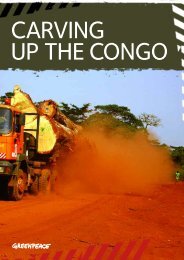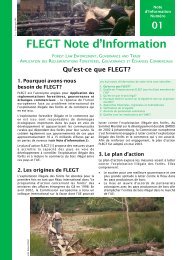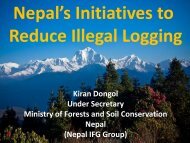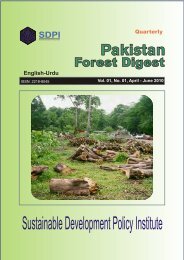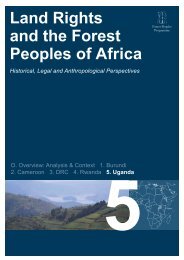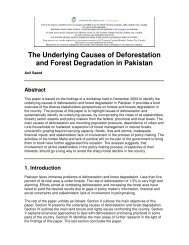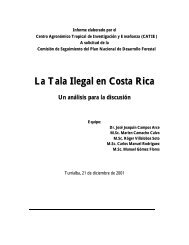conflict over natural resources at the community level in nepal
conflict over natural resources at the community level in nepal
conflict over natural resources at the community level in nepal
Create successful ePaper yourself
Turn your PDF publications into a flip-book with our unique Google optimized e-Paper software.
Forest Conflict <strong>in</strong> Nepal Through <strong>the</strong> Eyes of <strong>the</strong> PoorThis box summarizes relevant f<strong>in</strong>d<strong>in</strong>gs of a recent DFID-funded survey conducted by ForestAction <strong>in</strong>Nepal dur<strong>in</strong>g May and June, 2005 (K<strong>at</strong>tel et al. 2005). They captured <strong>the</strong> views and experiences of <strong>the</strong>people most affected by armed <strong>conflict</strong>, provid<strong>in</strong>g an important complement to <strong>the</strong> <strong>in</strong>form<strong>at</strong>ion upon whichour assessment is based. The ForestAction survey focused on understand<strong>in</strong>g how <strong>the</strong> Maoist <strong>in</strong>surgencyhas affected <strong>the</strong> livelihoods of <strong>the</strong> forest and tree-dependent poor and wh<strong>at</strong> <strong>the</strong>se people and <strong>the</strong>ir NGOservice providers perceive as <strong>the</strong> major problems fac<strong>in</strong>g <strong>the</strong> poor <strong>in</strong> <strong>the</strong> current environment. The surveyc<strong>over</strong>ed four districts, two <strong>in</strong> <strong>the</strong> hills and two <strong>in</strong> <strong>the</strong> Terai, and <strong>in</strong>cluded people from <strong>the</strong> follow<strong>in</strong>g fourgroups: resource-poor farmers, occup<strong>at</strong>ional castes and traders; landless rural people; and <strong>the</strong> urban poor.The ForestAction authors reach <strong>the</strong> follow<strong>in</strong>g summary conclusion based on <strong>the</strong> survey f<strong>in</strong>d<strong>in</strong>gs:“The problems prioritized by <strong>the</strong> focus groups and service providers <strong>in</strong> this survey are … fundamental,and rel<strong>at</strong>e to power, hierarchy, subord<strong>in</strong><strong>at</strong>ion and exploit<strong>at</strong>ion…The structures of resource access … arehistorically rooted <strong>in</strong> class dist<strong>in</strong>ctions th<strong>at</strong> distort even well-<strong>in</strong>tentioned policies <strong>in</strong> practice... The<strong>community</strong> forestry program <strong>in</strong> Nepal has led to some - but not sufficient - reform.”Based on this conclusion, <strong>the</strong> authors endorse <strong>the</strong> assertion th<strong>at</strong>:“Complete social transform<strong>at</strong>ion would be needed to address underly<strong>in</strong>g problems and end <strong>the</strong> <strong>conflict</strong>.”The authors also po<strong>in</strong>t out <strong>the</strong> irony th<strong>at</strong> <strong>the</strong> avowed purpose of <strong>the</strong> Maoist <strong>in</strong>surgency is to free <strong>the</strong> poorfrom <strong>the</strong> feudal system under which <strong>the</strong>y have suffered for centuries, but <strong>the</strong> cost of <strong>the</strong> war is be<strong>in</strong>gborne disproportion<strong>at</strong>ely by <strong>the</strong> poorest members of Nepalese society.Survey respondents identified <strong>the</strong> follow<strong>in</strong>g priority problems <strong>in</strong> <strong>the</strong>ir lives, many of which are caused orexacerb<strong>at</strong>ed by <strong>the</strong> <strong>in</strong>surgency:• Armed violence,• Strikes,• Lack of food security,• Lack of social security,• Lack of health services,• Unemployment and low <strong>in</strong>come caused by low wages and dim<strong>in</strong>ished wage labor opportunities,• Degrad<strong>at</strong>ion of or reduced access to <strong>n<strong>at</strong>ural</strong> <strong>resources</strong>,• Social discrim<strong>in</strong><strong>at</strong>ion,• Lack of control <strong>over</strong> decision mak<strong>in</strong>g,• Lack of awareness and educ<strong>at</strong>ion, and• AlcoholismThe respondents provided <strong>the</strong> follow<strong>in</strong>g details about those problems th<strong>at</strong> are of gre<strong>at</strong>est relevance to thisassessment:Lack of food security is caused by a number of factors; for example, many people have been forced toabandon <strong>the</strong>ir crops due to <strong>the</strong> physical danger of work<strong>in</strong>g <strong>in</strong> <strong>the</strong> fields; able-bodied family members haveei<strong>the</strong>r been conscripted by <strong>the</strong> Maoists or have fled to <strong>the</strong> cities, leav<strong>in</strong>g <strong>the</strong> old and sick who are unableto grow crops; Maoists soldiers demand to be fed; and <strong>the</strong>re is less wage employment available <strong>in</strong> ruralareas.Lack of social security is caused by <strong>the</strong> breakdown <strong>in</strong> social cohesion <strong>in</strong> rural areas because violenceand <strong>in</strong>timid<strong>at</strong>ion by both sides <strong>in</strong> <strong>the</strong> <strong>conflict</strong> has produced a general <strong>at</strong>mosphere of mistrust and aweaken<strong>in</strong>g of k<strong>in</strong>ship and social rel<strong>at</strong>ionships.Degrad<strong>at</strong>ion of or reduced access to <strong>n<strong>at</strong>ural</strong> <strong>resources</strong> is caused by use of forests as Maoist refugesand b<strong>at</strong>tlegrounds; efforts by <strong>the</strong> army to prevent local people from enter<strong>in</strong>g forests; and restrictions on<strong>community</strong> forest management by both sides. In <strong>the</strong> Terai, <strong>the</strong> poor have gre<strong>at</strong>er access to forest<strong>resources</strong> because st<strong>at</strong>e forests are no longer p<strong>at</strong>rolled by g<strong>over</strong>nment guards.CONFLICT OVER NATURAL RESOURCES AT THE COMMUNITY LEVEL IN NEPAL 11




